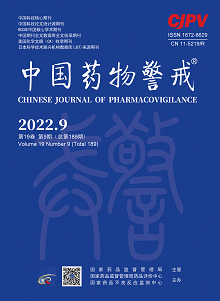|
|
Analysis and prevention of medication errors related to stored pharmaceuticals in National Monitoring Network for Clinical Safety Medication
ZHANG Qingxia, JIANG Yongxian, LI Gen, YAN Suying, WANG Yuqin
2022, 19(9):
1040-1044.
DOI: 10.19803/j.1672-8629.2022.09.23
Objective To analyze the current drug storage safety and identify the risks in the storage process of drugs so as to provide data for targeted precautions. Methods Reports about drug storage-related medication error (ME) were collected from the National Monitoring Network for Clinical Safety Medication between September 22, 2012 and September 30, 2020. The types of drugs involved, severity of errors, types of errors, where errors were made, the personnel who made these errors, and causes of errors were retrospectively analyzed statistically. Results The National Monitoring Network for Clinical Safety Medication received 67 storage-related ME reports from 33 hospitals in 15 provinces and cities across the country. The top three provinces and cities in terms of the number of reported cases were Beijing (24 cases, 35.82%), Anhui (17 cases, 25.37%) and Xinjiang (5 cases, 7.46%), involving 15 types of drugs. The top three types of drugs were hormones and endocrine-regulating drugs (17 cases, 25.37%), drugs for hematopoiesis (12 cases, 11.94%) and drugs for digestive diseases (7 cases,10.45%,). As for types of errors, there were 37 cases of temperature-related storage errors (55.22%), 19 cases (28.36%) of light-related errors, 6 cases (8.96%) of errors resulting from storage too close to children, and 3 cases (4.48%) of errors arising from too long storage after preparation, and 2 cases of humidity-related errors (2.99%). When it came to severity of errors, errors of class B were dominating (43 cases, 64.18%), followed by those of class C (9 cases, 13.43%), class D (6 cases, 8.96%), and class E (5 cases, 7.46%) and class F (4 cases, 5.97%). These errors involved 16 pharmacists (23.88%), 24 nurses (35.86%), 21 patients and family members (31.34%), 4 doctors (5.97 %) and equipment (2 cases, 2.99%). The most common causes of errors were lack of knowledge, insufficient training and personal negligence. Conclusion MEs relating to drug storage are not uncommon and have a wide range of causes. Related departments of hospitals should pay more attention to drug storage in the whole process of drug circulation so as to ensure the safety and effectiveness of clinical medications.
References |
Related Articles |
Metrics
|

